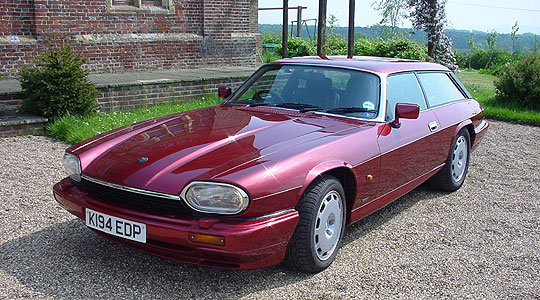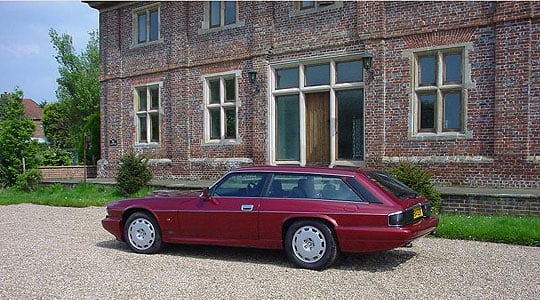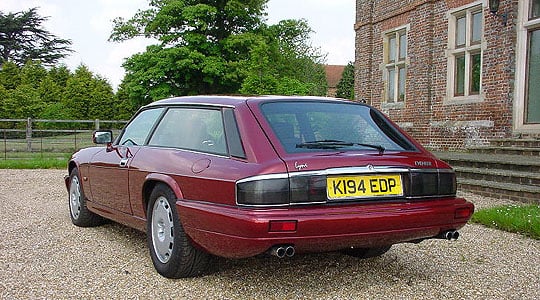
Why didn’t Jaguar do it themselves? Everyone wondered. A more practical, proper four-seater shooting-brake version of the XJS seemed an obvious development: one which would surely be a hit with golf-playing country types.
But it was left to Lynx, the UK-based engineering and design company, to create the Lynx Eventer – an estate car version of the XJS. The company certainly had the credentials. Founded in 1968, Lynx rapidly established itself as a reliable Jaguar specialist and in 1974 launched its own, more practical version of the Jaguar D-type at the London Racing Car Show. More than 50 of these cars were built and sold, including nine versions in XKSS form. Then came the company’s first foray into XJS development with the Lynx Spyder, a convertible version of the sports coupé – and, in 1982, it was followed by the Eventer.
Gone were the standard XJS coupé’s buttresses, to be replaced by an extended roof with rear and side windows offering a (relatively) vast expanse of glass. So here was a hand-built estate which addressed not only the XJS’s inadequate rear seating through its 3.5-inch addition to rear legroom, but also the coupé’s poor rear visibility. And then there was the generous rear hatch, allowing easy access to a bootspace which, while still small with the rear seats in place, gave golf-club-toting car-buyers the option to drop the seats and – hey presto – a stylish, practical alternative to either the severely limited standard XJS, or the more featureless volume production estates on the market.
This was something genuinely hand-crafted; but what amazed pundits at the time was how competent the Eventer was to drive. The rearward shift in weight distribution required stiffer rear suspension but the XJS accepted this modification gracefully. And if punters expected the performance to plummet, they were in for a surprise: the Eventer actually weighed less than the standard XJS – so acceleration was sharper. Even mainstream manufacturers often compromise the handling of their products when they convert a saloon to a soft-top, or a coupé to an estate. But here was a small, home-grown engineering company with the vision – and the skills – to create a car that drove like the product of a multi-million pound R&D programme, matched by a level of finishing and detail to rival the best.

With each car built strictly to order on a custom-made jig (taking 14 weeks from order to delivery), the Eventer could be created either from a customer’s existing XJS or based on a brand-new car. Hence the Eventer ‘model range’ reflected Jaguar’s full array of six-cylinder and V12 XJS models – along with many of the highly desirable upgrades available as options on the manufacturer-built car, such as nylon steering bushes.
According to John Mayston-Taylor, former Chairman and Managing Director of Lynx, just 67 Eventers were built over the 16 years of its production, so they are a rare sight today. The last of these models, delivered to the final Eventer customer in Summer 2002, is the car we’ve pictured here. It’s based on a late-model XJR-S 6.0-litre. Says Mayston-Taylor, “As I recall, it really performed…”.
As for Lynx itself, the story is about to start an exciting new page in its history. It has just been announced (March 2009) that John Mayston-Taylor has sold Lynx Motors International to a UK company – and the new Managing Director is Anthony (Tony) Gott, former CEO of Rolls-Royce and Bentley Motors.

Meanwhile, Mayston-Taylor will continue to provide project management, consultancy and ‘specialist restorations of historically significant vehicles’ as Mayston Taylor & Company Ltd. Regarding the sale of Lynx, Mayston-Taylor says he’s “delighted to confirm that the company will be continuing its tradition for hand-built sports cars using traditional methods of craftsmanship with our renowned attention to detail”. The plan is to keep the Lynx C-Type, Lynx D-Type & XKSS and Lynx Lightweight E-Type in production – while future projects might just include a Lynx sports car. And the company will remain firmly in the UK, with activities based around its current facilities in Berkshire and Hampshire.
Text: Charis Whitcombe
Photos: Lynx
ClassicInside - The Classic Driver Newsletter
Free Subscription!



